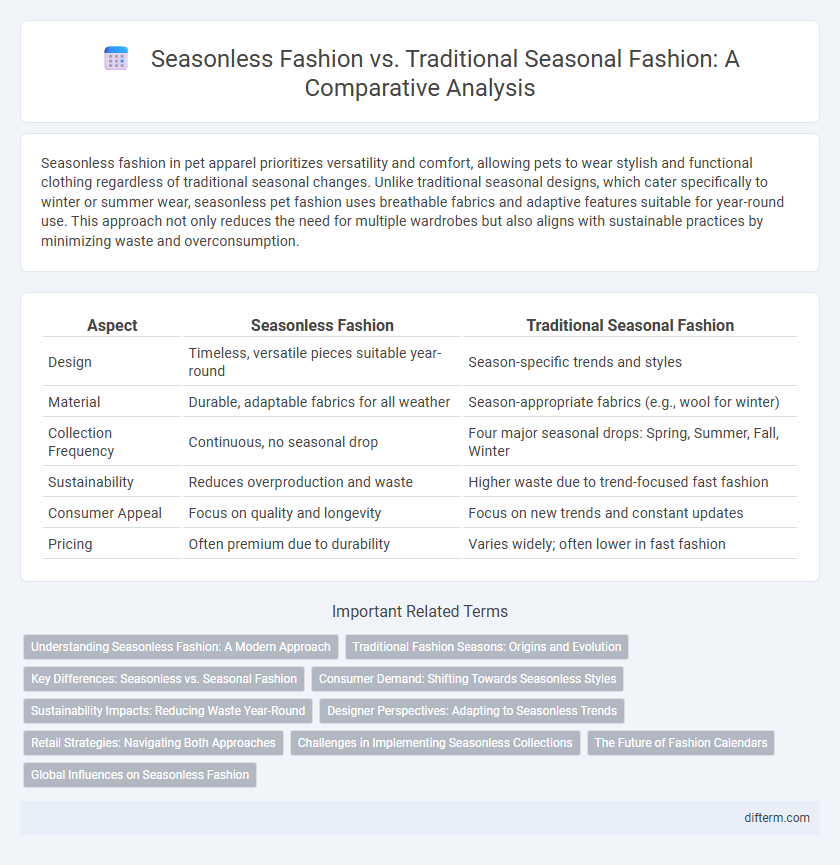Seasonless fashion in pet apparel prioritizes versatility and comfort, allowing pets to wear stylish and functional clothing regardless of traditional seasonal changes. Unlike traditional seasonal designs, which cater specifically to winter or summer wear, seasonless pet fashion uses breathable fabrics and adaptive features suitable for year-round use. This approach not only reduces the need for multiple wardrobes but also aligns with sustainable practices by minimizing waste and overconsumption.
Table of Comparison
| Aspect | Seasonless Fashion | Traditional Seasonal Fashion |
|---|---|---|
| Design | Timeless, versatile pieces suitable year-round | Season-specific trends and styles |
| Material | Durable, adaptable fabrics for all weather | Season-appropriate fabrics (e.g., wool for winter) |
| Collection Frequency | Continuous, no seasonal drop | Four major seasonal drops: Spring, Summer, Fall, Winter |
| Sustainability | Reduces overproduction and waste | Higher waste due to trend-focused fast fashion |
| Consumer Appeal | Focus on quality and longevity | Focus on new trends and constant updates |
| Pricing | Often premium due to durability | Varies widely; often lower in fast fashion |
Understanding Seasonless Fashion: A Modern Approach
Seasonless fashion challenges traditional seasonal wardrobes by emphasizing versatile, timeless pieces suitable for any time of the year. This modern approach reduces waste and promotes sustainability by encouraging consumers to invest in high-quality garments that transcend fleeting trends. Brands adopting seasonless collections focus on durable fabrics and classic silhouettes, reshaping the fashion industry's production and consumption cycles.
Traditional Fashion Seasons: Origins and Evolution
Traditional fashion seasons originated from historical weather patterns and agricultural cycles, dividing collections into spring/summer and fall/winter categories. This system shaped retail calendars and design processes for decades, influencing production timelines and consumer expectations. Over time, globalization and climate changes challenged these rigid seasonal boundaries, prompting designers to reconsider the relevance of traditional fashion seasons.
Key Differences: Seasonless vs. Seasonal Fashion
Seasonless fashion emphasizes timeless, versatile pieces designed to be worn year-round, reducing the need for constant wardrobe updates tied to traditional seasonal changes. Traditional seasonal fashion focuses on distinct collections for spring, summer, fall, and winter, often highlighting trends and fabrics specific to each period. Key differences include material choices prioritizing durability in seasonless fashion versus trend-driven, seasonal textiles, and a focus on sustainability through reduced consumption compared to the fast turnover of seasonal styles.
Consumer Demand: Shifting Towards Seasonless Styles
Consumer demand is increasingly shifting toward seasonless fashion as buyers prioritize versatile wardrobe staples that transcend traditional seasonal boundaries. Shoppers seek timeless pieces crafted from sustainable materials, reflecting a growing preference for durability and year-round wearability over fast fashion trends. This shift influences brands to invest in collections emphasizing adaptability, comfort, and eco-conscious production methods.
Sustainability Impacts: Reducing Waste Year-Round
Seasonless fashion promotes sustainable practices by minimizing production cycles tied to traditional seasons, leading to less overproduction and textile waste throughout the year. Brands adopting seasonless collections focus on timeless, versatile pieces that reduce consumer demand fluctuations, thereby lowering carbon footprints and resource consumption. Emphasizing durability and classic styles in seasonless fashion supports circular economy principles, significantly decreasing landfill contributions and environmental strain.
Designer Perspectives: Adapting to Seasonless Trends
Designers increasingly embrace seasonless fashion by prioritizing timeless silhouettes and versatile fabrics that transcend traditional seasonal boundaries. This approach fosters sustainable practices and allows creative freedom, shifting focus from fast-paced trend cycles to enduring style innovation. By integrating seasonless collections, designers respond to evolving consumer demands for wardrobe longevity and environmental responsibility.
Retail Strategies: Navigating Both Approaches
Retail strategies in fashion must adapt to the rise of seasonless fashion by emphasizing versatile, timeless pieces that appeal year-round, contrasting with traditional seasonal collections centered on timely trends and inventory turnover. Brands invest in flexible supply chains and data-driven demand forecasting to balance the steady flow of seasonless items alongside limited, season-specific launches. Integrating digital platforms enhances personalized marketing and inventory management, enabling retailers to navigate consumer preferences in both seasonless and traditional seasonal models efficiently.
Challenges in Implementing Seasonless Collections
Implementing seasonless fashion collections poses significant challenges such as predicting consumer demand without clear seasonal trends and managing inventory to avoid overstock or stockouts throughout the year. Brands must also adapt supply chains to enable quick responsiveness and flexibility, overcoming the conventional calendar-based production cycles. These obstacles require innovative design approaches and data-driven decision-making to ensure profitability and sustainability in a constantly evolving market.
The Future of Fashion Calendars
Seasonless fashion disrupts traditional fashion calendars by prioritizing timeless, versatile pieces over seasonal trends, promoting sustainability and reducing waste. Designers and retailers increasingly adopt continuous collections that respond to consumer demand for adaptability rather than fixed fashion cycles. This shift challenges historical buying patterns, encouraging a more fluid, year-round approach to fashion innovation and consumption.
Global Influences on Seasonless Fashion
Global influences drive the rise of seasonless fashion by blending diverse cultural aesthetics and climate-responsive designs that transcend traditional seasonal cycles. Innovations in sustainable materials and digital retail platforms enable designers worldwide to launch collections accessible year-round, disrupting conventional fashion calendars. This shift promotes inclusivity and adaptability, catering to consumers in varied geographical regions and climates.
seasonless fashion vs traditional seasons Infographic

 difterm.com
difterm.com